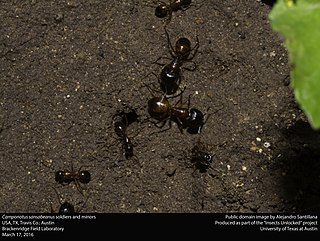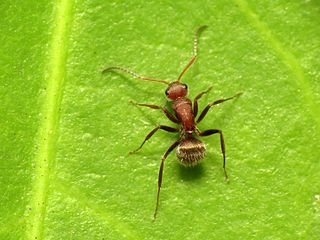Related Research Articles

Honey ants, also called honeypot ants, are ants which have specialised workers that are gorged with food to the point that their abdomens swell enormously. Other ants then extract nourishment from them, through the process of trophallaxis. They function as living larders. Honeypot ants belong to any of several genera, including Myrmecocystus and Camponotus. They were first documented in 1881 by Henry C. McCook, and described further in 1908 by William Morton Wheeler.

Carpenter ants are large ants indigenous to many forested parts of the world.

The banded sugar ant, also known as the sugar ant, is a species of ant native to Australia. A member of the genus Camponotus in the subfamily Formicinae, it was described by German entomologist Wilhelm Ferdinand Erichson in 1842. Its common name refers to the ant's liking for sugar and sweet food, as well as the distinctive orange-brown band that wraps around its gaster.

Monomorium is a genus of ants in the subfamily Myrmicinae. As of 2013 it contains about 396 species. It is distributed around the world, with many species native to the Old World tropics. It is considered to be "one of the more important groups of ants," considering its widespread distribution, its diversity, and its variety of morphological and biological characteristics. It also includes several familiar pest species, such as the pharaoh ant and the flower ant.
Colobopsis anderseni, synonym Camponotus anderseni, is a species of mangrove ant found in northern Australia.

Notostigma is a genus of ants in the subfamily Formicinae and the sole member of the tribe Notostigmatini. Its two species are known only from Australia. Workers are nocturnal and forage solitarily. Notostigma was first described by Emery (1920), when he erected the new genus for three species of carpenter ants (Camponotus).

Camponotus aurocinctus is a species of ant in the genus Camponotus. The ant was described by Smith in 1858.

The black-headed sugar ant, also known as the brown sugar ant, is a species of Formicinae ant endemic to Australia. Found throughout most states, the species is a member of the genus Camponotus, a cosmopolitan genus of ants commonly known as carpenter ants. It was formally described and named by British entomologist Frederick Smith in 1858. These ants are characterised by their black head, reddish-brown mesosoma and black gaster, which can change in colour.
Camponotus dryandrae is a species of ant in the genus Camponotus. Described by McArthur in 1996, the species is restricted to Western Australia.
Camponotus eastwoodi is a species of ant in the genus Camponotus. Described by McArthur in 1996, the species is restricted to Queensland and New South Wales.
Camponotus loweryi is a species of ant in the genus Camponotus. Described by McArthur in 1996, the species is found in multiple states in Australia.
Camponotus longideclivis is a species of ant in the genus Camponotus. Described by McArthur in 1996, the species is restricted to Western Australia.
Camponotus pallidiceps is a species of ant in the genus Camponotus. Described by Emery in 1887, the species is restricted to New South Wales.
Camponotus prostans is a species of ant in the genus Camponotus. Described by Forel in 1910, the species is restricted to Western Australia.

Camponotus sansabeanus is a species of ant in the family Formicidae.

Camponotus sexguttatus is a species of ant in the family Formicidae.

Camponotus planatus, known generally as the compact carpenter ant or short carpenter ant, is one of three Camponotus species that is polygynous, it also is a species of ant in the family Formicidae.

Camponotus quercicola is a species of ant in the family Formicidae that is endemic to California and commonly nests in oak trees, as they usually inhabit oak forests.
Camponotus textor, also known as Brazilian weaver ant, is a species of fairly common tree-dwelling ant native to South and Central America. It is believed to include a number of cryptic species, and previously were considered synonymous to the cavity-dwelling ant Camponotus senex, now thought to be only distantly-related.
References
- ↑ "Results for the species Camponotus triodiae McArthur". Hymenoptera Name Server. Archived from the original on 21 July 2011. Retrieved 23 August 2010.
- ↑ McArthur, A. J. (2009). "New species, new status and new synonymy for Camponotus from Australia (Hymenoptera: Formicidae)". Myrmecological News . 12: 273–286.
| This Formicinae-related article is a stub. You can help Wikipedia by expanding it. |
| This Australia-related article is a stub. You can help Wikipedia by expanding it. |